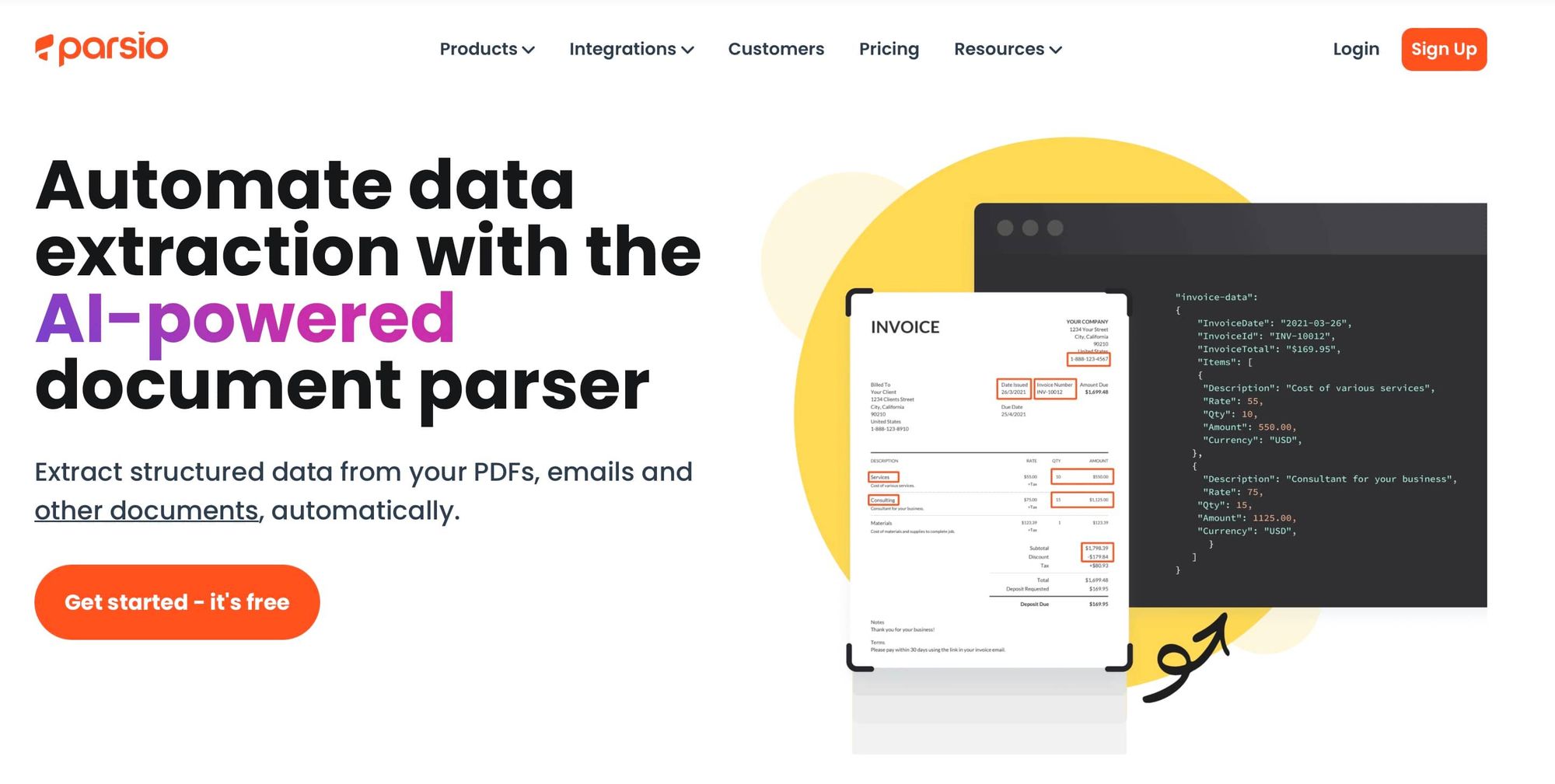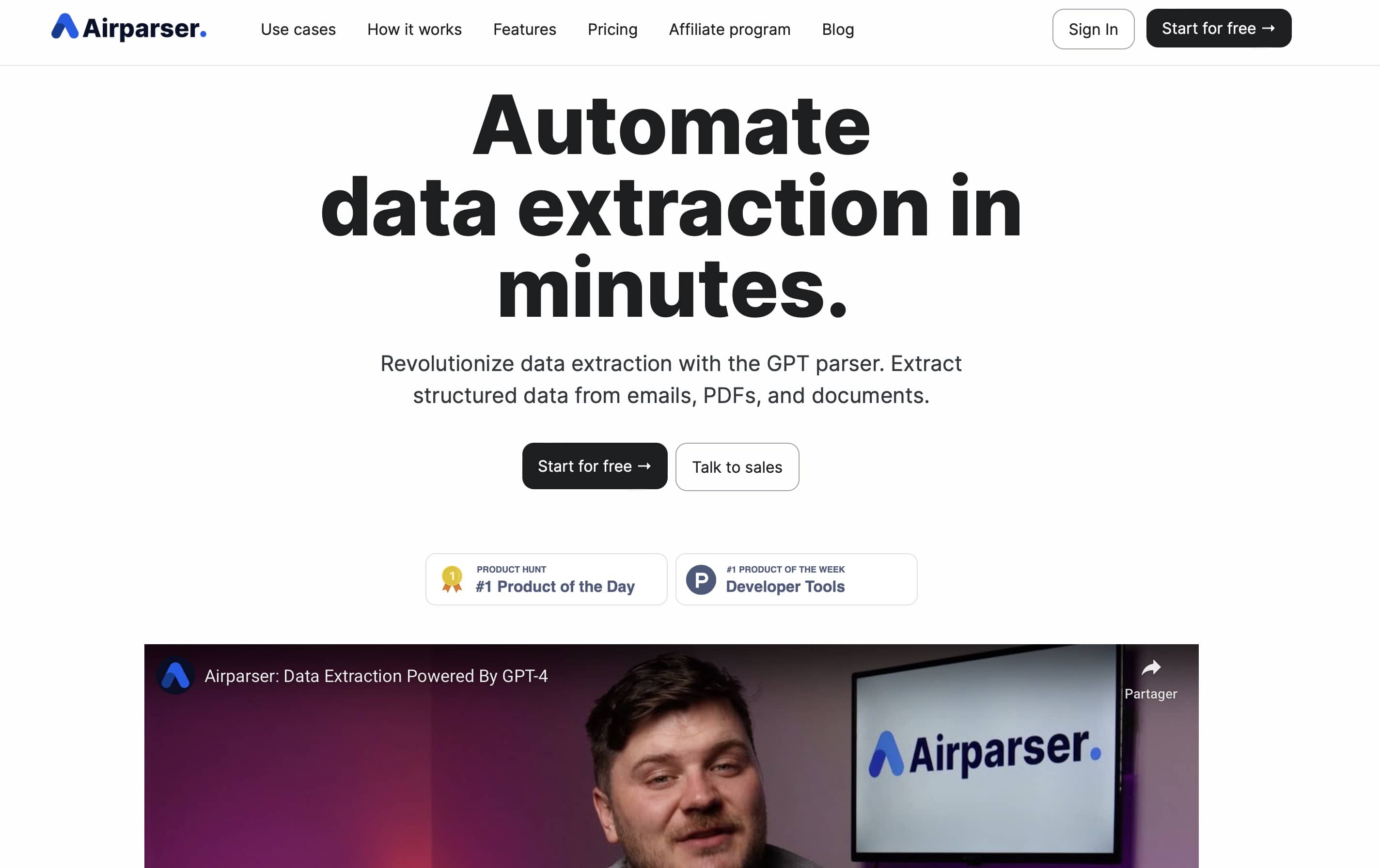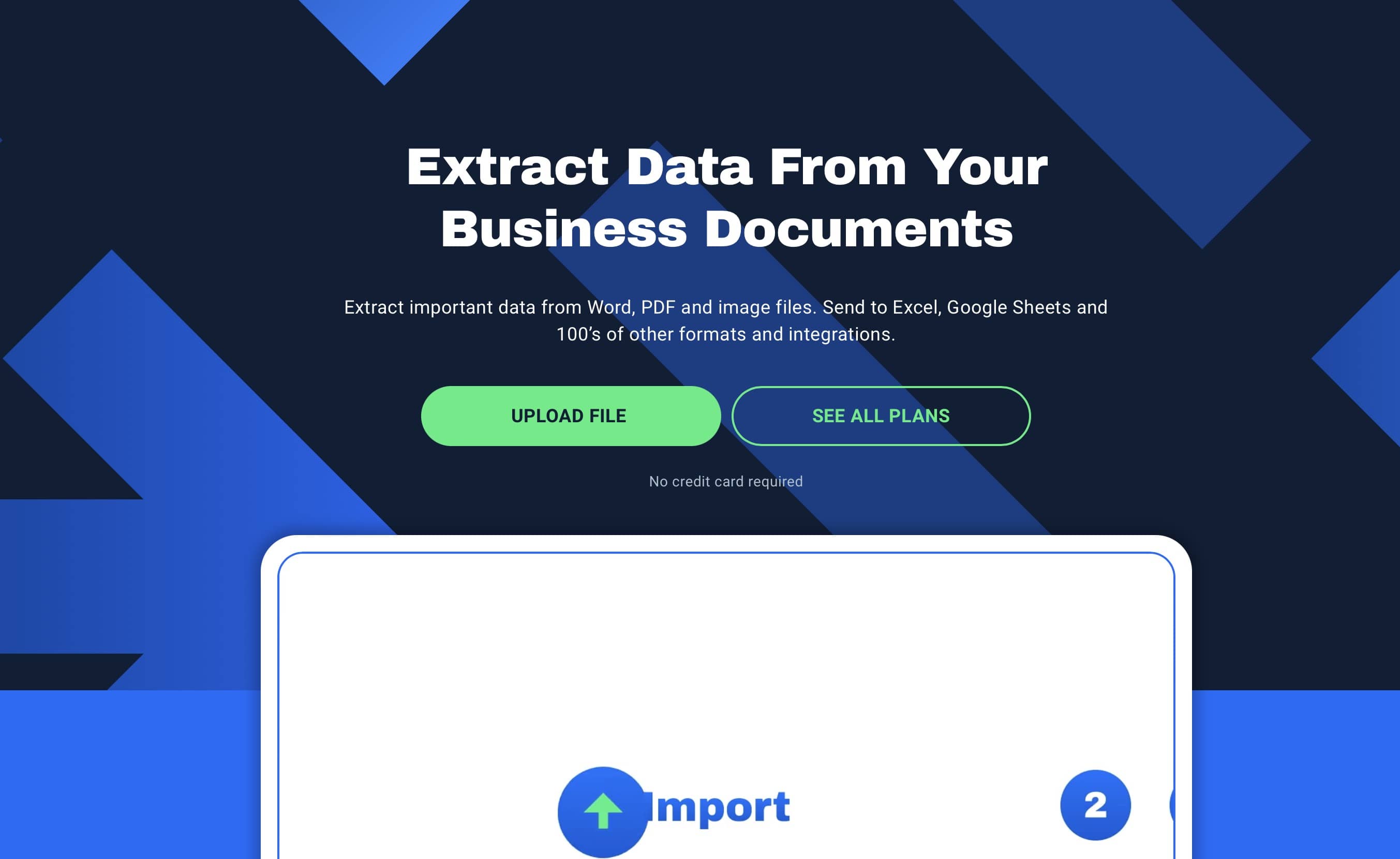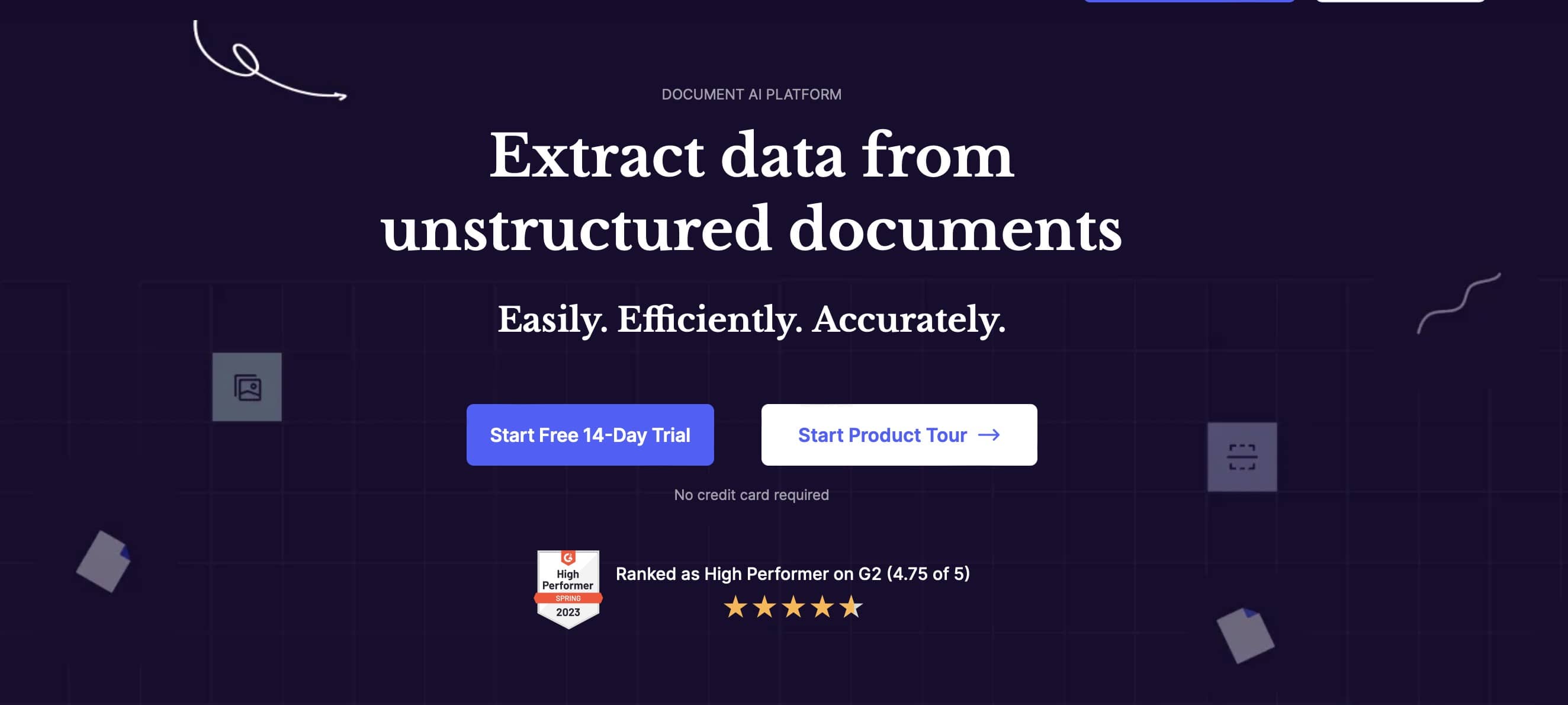Top 5 PDF Parsing Software in 2025
Discover the best PDF parsing software in 2025 for efficient data extraction. We compare features, use cases, and pros & cons to help you choose the ideal solution for your needs. Streamline your document processing with our top picks.

PDF parsing software plays an important role in extracting valuable information efficiently and accurately. Among the various options available, choosing the right one becomes a tedious process.
In this article, we will discuss the 5 best PDF parsing software in 2025. These include Parsio, Airparser, Nanonets, Docparser, and Docsumo. This comparative analysis aims to explain their features, use cases, and the pros and cons associated with each, allowing you to make an informed choice for your document parsing needs.
1. Parsio
Parsio, known for its efficiency and versatility, is an AI-powered document parser. The robust technology enables precise extraction of data from complex documents, making it ideal for diverse use cases ranging from financial reports to legal documents. Alongside its user-friendly interface and customizable features, Parsio also enables parsing of documents in different languages, including Latin and European. From emails to PDFs and human written text, Parsio can extract data efficiently from various sources. It offers GPT parser making document parsing easy and accurate.

Use Cases
Financial Reporting: Parsio excels in extracting data from financial statements, invoices, and receipts, facilitating seamless financial reporting and analysis. Its accuracy and speed ensure reliable extraction of critical information, streamlining accounting processes and minimizing errors.
Legal Documentation: With its advanced parsing capabilities, Parsio simplifies the extraction of data from legal contracts and agreements. This enables legal professionals to efficiently review and analyze documents, saving valuable time and ensuring compliance with regulatory requirements.
Human Resources Management: In HR departments, Parsio aids in extracting data from resumes, job applications, and employee contracts. This facilitates efficient recruitment processes, enables analysis of candidate profiles, and ensures compliance with employment regulations.
Customer Relationship Management (CRM): Within CRM systems, Parsio assists in extracting customer data from invoices, purchase orders, and correspondence documents. This enables businesses to maintain accurate customer records, track interactions, and personalize communication effectively.
Features
Document Types: Parsio leverages machine learning algorithms to accurately parse various document types. These include PDFs, emails, scanned documents (images) and other document types, even from complex and unstructured documents. This ensures high accuracy in data extraction, minimizing errors and enhancing productivity for businesses.
Technologies Used: Parsio uses template-based parser for transactional emails and documents with constant layout. For documents like PDFs, scanned documents, invoices, ID documents, tables, business cards, and forms, Parsio leverages AI-powered parser equipped with pre-trained models. It also provides you with a GPT-powered parser for unstructured documents. The AI-powered OCR engine to handle scanned documents and even handwritten text.
Customizable Templates: With customizable parsing templates, Parsio allows users to define specific extraction rules tailored to their unique requirements. This flexibility enables seamless adaptation to diverse document formats and layouts.
Batch Processing: Parsio supports batch processing, enabling users to parse multiple PDFs simultaneously. This feature enhances efficiency, particularly in scenarios involving large volumes of documents, such as bulk invoice processing or document archiving.
Integration Capabilities: Parsio offers seamless integration with more than 6,000 platforms and applications, including Google Sheets, Slack, Dropbox, and accounting apps via webhooks, Zapier, and Make. One can download data as CSV, JSON, and Excel. This ensures smooth interoperability and facilitates streamlined workflows across multiple tools.
Pros
User-Friendly Interface: Its intuitive interface makes Parsio accessible to users of all skill levels, minimizing the learning curve and expediting the parsing process.
Scalability: Parsio is highly scalable, capable of handling large volumes of documents efficiently, making it suitable for organizations of all sizes.
Customization Options: The ability to create custom parsing templates allows users to tailor Parsio to their specific needs, enhancing flexibility and adaptability.
Pricing: Parsio, when compared to other parsing tools, is highly cost-effective. Even the free plan offers OCR, AI, and GPT-powered parsers.
Cons
Learning Curve: Despite its user-friendly interface, learning advanced features and customization options within Parsio may require additional time and training for some users.
2. Airparser
Airparser leverages the capabilities of GPT-powered parsing technology to efficiently extract data from various sources. It enables seamless parsing of emails and scanned documents by using AI OCR engine. This powerful combination empowers users to effortlessly extract valuable information from email communications and digitized documents, enhancing productivity and streamlining data-intensive workflows. Whether it's processing incoming emails or extracting data from scanned images, Airparser's GPT-powered parsing capabilities ensure accuracy and reliability, making it an invaluable tool for businesses across industries.

Use Cases
Contract Management: Airparser aids legal professionals in parsing legal contracts, agreements, and compliance documents, extracting key clauses, dates, and parties involved. This enables efficient contract review, compliance monitoring, and contract lifecycle management, reducing legal risks and ensuring regulatory adherence.
Resume Screening and Recruitment: Airparser streamlines the recruitment process by extracting candidate information, skills, and experience from resumes in PDF format. This allows HR professionals to efficiently screen applicants, identify qualified candidates, and expedite the hiring process.
Handwritten Text Recognition: Airparser's advanced capabilities extend to extracting information from handwritten text in PDF documents. This feature enables the digitization of handwritten forms, notes, and documents, enhancing data accessibility and usability in various industries such as education, research, and logistics.
Features
AI-Powered Parsing Algorithms: Airparser extracts data from scanned documents using AI OCR engine. This enables it to extract data from structured as well as unstructured documents. From human-written emails, contracts, invoices, etc, Airparser makes data extraction seamless. The AI OCR engine minimizes manual intervention and enhances parsing efficiency across diverse document formats.
Customizable Extraction Rules: Airparser offers customizable extraction rules, allowing users to define specific parsing criteria tailored to their document requirements. This flexibility enables precise extraction of relevant information while accommodating variations in document layouts and structures.
Integration with Third-Party Applications: Airparser supports seamless integration with a wide range of third-party applications and platforms such as Google Sheets, QuickBooks, Xero, Slack, and others via Zapier, Make, and webhooks. This facilitates interoperability and enhances workflow automation across multiple tools and processes.
Pros
High Accuracy: With its GPT-powered parser, Airparser ensures high accuracy and efficiency in extracting data from PDF documents, minimizing errors and reducing processing time compared to manual methods.
Ease of Integration: Airparser seamlessly integrates with a variety of existing software solutions, allowing for smooth interoperability and workflow automation without disrupting established processes. With Zapier and Make, you can export data in real-time to Google Sheets and over 6000 apps. It is also easy to download data as Excel, CSV, and JSON.
User-Friendly Interface: Airparser has a user-friendly interface, making it accessible to users of all skill levels. The intuitive design minimizes the learning curve, allowing for seamless navigation through parsing tasks.
GPT-Powered Parser: The GPT-powered parser offered by Airparser is more advanced compared to that offered by Parsio.
Cost-Efficient: Airparser is arguably the most cost-effective GPT-powered parser currently available in the market. With its competitive pricing model, Airparser offers outstanding value for businesses seeking advanced data extraction solutions without breaking the bank.
Cons
Unavailability of Free Plan: Airparser does not provide a free plan but there is a free trial plan to test out the parsing tool.
3. Nanonets
Nanonets is another parsing tool that comes with OCR technology, thereby enabling seamless extraction of structured data from unstructured documents. Businesses can use the parsing software to extract information from a diverse set of documents. Nanonets' API-first approach offers seamless integration with existing workflows, thus enhancing efficiency and productivity.

Use Cases
Invoice Processing: Nanonets excels in extracting relevant data from invoices, including vendor details, line items, and total amounts. This streamline accounts payable processes, accelerates invoice reconciliation, and improves financial visibility for businesses.
Receipt Management: Nanonets aids in extracting information from receipts, such as transaction dates, itemized purchases, and payment methods. This simplifies expense tracking, budget management, and reimbursement processes for individuals and organizations.
Email Parsing: Nanonets enables the extraction of key information from emails and attachments, such as order confirmations, shipping notifications, and financial statements. This enhances email management efficiency, reduces manual data entry, and ensures timely response to critical information.
Features
OCR: Nanonets utilizes OCR technology to accurately recognize and extract text from images and scanned documents. This enables seamless digitization of paper-based content, enhancing data accessibility and usability.
Customizable Data Extraction: Nanonets offers customizable data extraction templates, allowing users to define specific parsing rules tailored to their document requirements. This flexibility ensures accurate extraction of relevant information while accommodating variations in document layouts and structures.
API Integration: Nanonets provides API integration capabilities, enabling seamless integration with existing software systems and workflows. This facilitates automated data extraction and workflow automation, improving productivity and reducing manual effort.
Pros
Versatility: Nanonets' ability to extract information from various sources, including PDFs, emails, invoices, and receipts, makes it a versatile solution for diverse use cases across industries.
Scalability: Nanonets' scalable architecture allows for processing large volumes of documents efficiently, making it suitable for organizations of all sizes.
Customization Options: Nanonets offers customizable data extraction templates, enabling users to tailor parsing rules to their specific requirements. This flexibility enhances adaptability and ensures accurate extraction of relevant information.
Cons
Limited Free Tier: Nanonets' free tier has limitations on usage or features, which restricts access for users with budget constraints or smaller-scale parsing needs.
No GPT Parser: Nanonets lacks a GPT parser, which limits its ability to handle certain complex parsing tasks or extract contextual information from documents.
Pricing: The price for Nanonets starts from $499 per month and per document type. This might not be suitable for small businesses.
4. Docparser
Unlike other parsing tools, Docparser is not AI-powered. It makes use of Zonal OCR technology to extract data. Docparser's interface is slightly outdated, which can make parsing tedious for users at times. While it can parse PDFs, Word files, and images, the parsing engine is not capable of extracting information from emails, excel, and other document types. Furthermore, creating a custom parsing template is also a cumbersome process

Use Cases
Invoice Processing: Docparser automates the extraction of key information from invoices, such as vendor details, line items, and totals.
Form Data Extraction: Docparser assists in extracting data from various types of forms, including surveys, applications, and registration forms that are available in PDF and word format.
Features
Customizable Parsing Rules: Docparser offers customizable parsing rules, allowing users to define specific extraction criteria tailored to their document requirements.
Integration Capabilities: Docparser integrates with a variety of third-party applications and platforms.
Pros
High Accuracy: Docparser delivers high accuracy in data extraction from document types such as PDF and images. However, this is only for documents with the same layout.
Free Plan: Docparser provides users with a free plan, however, it comes with a limited set of features.
Cost-Efficient: Docparser is among the most cost-efficient parsing solutions available in the market. The prices start at $39 per month. There is a 14-day free trial available too.
Cons
Only Zonal OCR: Only zonal OCR is available in Docparser. Thus, it is also suited to handle documents with the same layout. It means that for parsing invoices one needs to create a new template for each vendor, as different vendors use different invoice layouts.
Lack of AI and GPT Parsers: Unlike some competing solutions, Docparser currently lacks AI and GPT parsers to handle more complex cases.
Lack of Email Parser: Docparser cannot process emails, only documents like PDFs are supported.
Outdated Interface: Some users may find Docparser's interface to be outdated and less intuitive compared to modern document parsing solutions.
5. Docsumo
Docsumo combines AI-driven parsing technology with intuitive features to streamline document processing workflows effectively. Docsumo's focus on user experience is evident in its user-friendly interface and extensive documentation, ensuring a smooth onboarding process for users.

Use Cases
Document Types: Docsumo streamlines invoice processing by extracting key information such as vendor details, line items, and totals from invoices. Furthermore, it can also help in extracting information from bank statements and utility bills.
Receipt Management: Docparser aids in extracting information from receipts, such as transaction dates, itemized purchases, and payment methods.
Features
AI-Powered Data Extraction: Docsumo leverages artificial intelligence algorithms to accurately extract data from unstructured documents, including PDFs, images, and scanned documents. This technology ensures high accuracy in data extraction, even from complex and varied document formats.
Customizable Extraction Templates: Docsumo offers customizable extraction templates, allowing users to define specific parsing rules tailored to their document requirements.
Pros
Easy-to-Use Interface: Docsumo features a user-friendly interface that's simple to navigate, catering to users with varying levels of technical expertise.
Seamless Integration: Docsumo seamlessly integrates with existing systems such as CRMs, ERPs, and in-house software. It can export data in preferred formats like MS Excel and JSON, ensuring smooth integration with existing workflows.
Cons
Limited Document Compatibility: Docsumo's AI technology is optimized for structured documents like invoices, receipts, and bills. However, it might struggle with more complex or unstructured documents.
Limited Feature Set: Docsumo lacks certain advanced features when compared to other alternatives available.
Price: Docsumo’s pricing is at the higher end with prices starting from $500 per month. As a result, it might not be suited for small businesses.
Email parsing: Unlike some other document processing tools, Docsumo does not offer native support for parsing and extracting information from emails.
Conclusion
Choosing the right solution requires a thorough understanding of each tool's capabilities and limitations. While Parsio, Airparser, Nanonets, Docparser, and Docsumo are among the best that are available, each of these tools have different use cases and make use of different technologies to extract data from documents.
Furthermore, tools like Parsio, Airparser, and Docparser are cost-efficient, compared to Nanonets and Docsumo. Thus, choose the tool which is best suited for your data extraction needs and budget.
